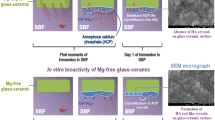Summary
CaO, SiO2-based glasses form the bonelike apatite on their surfaces in an acellular simulated body fluid (SBF) with ion concentrations nearly equal to those of the human blood plasma. The apatite formation of the former glasses is attributed to the catalytic effect of the Si-OH groups, which are formed on their surfaces in SBF, for the apatite nucleation. The gels of SiO2, TiO2, ZrO2, Ta2O5, and Nb2O5 formed the apatite on their surfaces in SBF, but Al2O3 gel did not. This indicates that the Ti-OH, Zr-OH, Ta-OH and Nb-OH groups besides the Si-OH groups are also effective for the apatite nucleation, but Al-OH groups are not effective. Apatite formation on self-assembled monolayer terminated with various functional groups in SBF showed that COOH and H2PO4 groups are also effective for the apatite nucleation. All these groups are negatively charged around pH 7.40. Their apatite nucleating ability is varied with their arrangements. Among the Ti-OH groups, those in anatase structure are most effective for the apatite nucleation. Transmission electron microscope attached with energy dispersive X-ray spectrometer showed that these functional groups induce the apatite nucleation not directly, but through formation of their calcium compounds and subsequent formation of amorphous calcium phosphate with low Ca/P atomic ratios.
Similar content being viewed by others
Author information
Authors and Affiliations
Rights and permissions
About this article
Cite this article
Kokubo, T., Kim, HM., Kawashita, M. et al. Process of calcification on artificial materials. Z Kardiol 90 (Suppl 3), 86–91 (2001). https://doi.org/10.1007/s003920170048
Issue Date:
DOI: https://doi.org/10.1007/s003920170048



